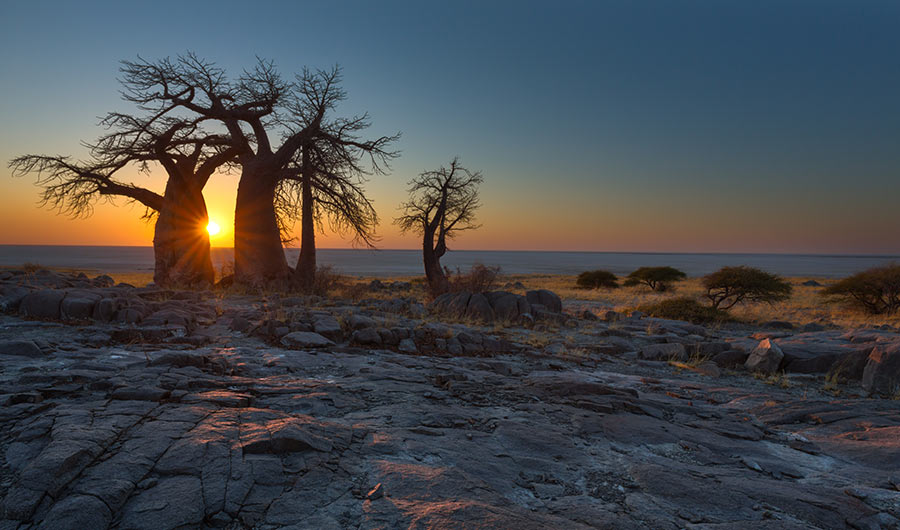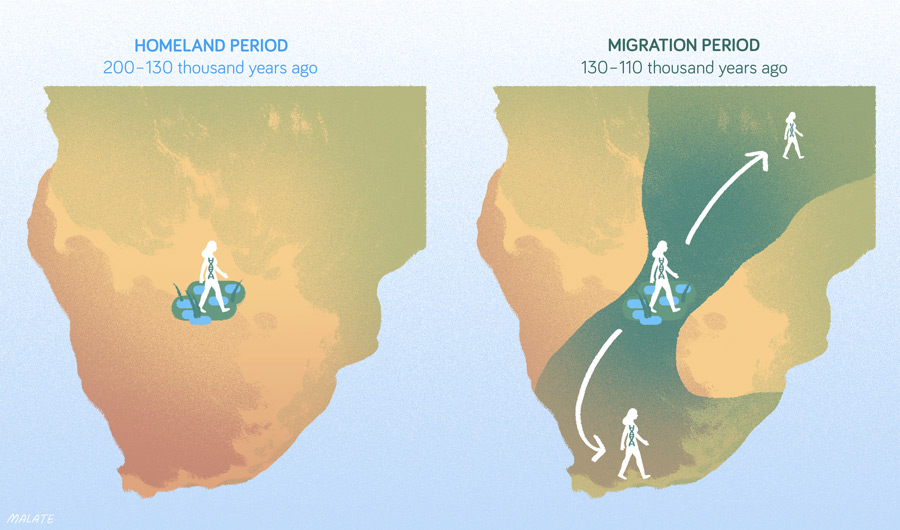Experts Skeptical of New Study Pinpointing the Birthplace of Humanity

The rock outcrop known as Kubu Island in Botswana lies within the region where some researchers claim modern humans first evolved.
Hannes Thirion/Shutterstock
(Inside Science) -- It's an appealing story because it's simple. Modern humans arose in a fertile wetland centered on what is now northern Botswana, then spread northeast and southwest in two migration waves between 130,000 and 110,000 years ago.
This scenario was presented in an article published Monday in Nature, one of the world's most prestigious scientific journals. But none of the eight outside experts who responded to Inside Science's requests for comment said there was strong support for that exact narrative. Two thought the data supported a more limited version of the authors' conclusions, and six had serious concerns about the study.
"I am hugely surprised that this study made it into an important scientific journal," wrote Mattias Jakobsson, a population geneticist at Uppsala University in Sweden, in an email.
A simple story
Most of a person's DNA is packaged into 46 chromosomes and housed in the nuclei of their cells. But there is another portion of DNA found outside the nucleus, in the mitochondria. This is what the new study focused on. Mitochondrial DNA is passed directly from mother to child without being mixed up with DNA from the father.
If you were to trace this maternal line backward from everyone living today, you would eventually arrive at a single female ancestor nicknamed "mitochondrial Eve." (Other parts of our genome can theoretically be traced to different common ancestors.) Mitochondrial Eve need not have been a modern human, but she gave rise to two major branches of descendants, and scientists use the mutations that have accumulated on these branches to tell them apart. The rarer branch is called L0, and its signature DNA types are found almost exclusively in people living in southern Africa. In the new study, the researchers collected genetic samples from 198 people, focusing on subtypes of L0 that had not been extensively studied.
When the researchers combined the new genetic data with previously collected samples from more than 1,100 people, they were able to map out the history of the L0 lineage in more detail than ever before. They found that L0 emerged about 200,000 years ago, with various subtypes branching off at later dates. Several experts who were not involved in the research praised this part of the study.
"In many ways the paper is really nice," said Murray Cox, a molecular anthropologist at Massey University in New Zealand. "They've managed to fill in a particular gap, which is these really, really old lineages of the mitochondrial DNA tree."
Next, the researchers combined their genetic analysis with other lines of evidence to infer where ancient populations lived and moved. They modeled historical climate across southern Africa, and compared the times when the climate changed to branching events in the mitochondrial DNA tree. They related these findings to linguistic and cultural data and the locations where the DNA donors lived.
"We could pinpoint what we believe is our own human homeland," said study author Vanessa Hayes of the Garvan Institute of Medical Research in Australia during a press briefing. "We've known for a long time that modern humans originated in Africa … but what we haven't known until this study was where exactly this homeland was."
They found that when L0 split off from the rest of the mitochondrial lineage, much of southern Africa would have been dry and inhospitable. But across what is now northern Botswana and extending slightly into Namibia and Zimbabwe, there was a lush, lake-dotted oasis -- the perfect place for ancient humans to have lived, according to Axel Timmermann, a climate scientist at Pusan National University in South Korea, who developed the climate model and is one of the study's authors.
The region is much drier today, but it is still home to peoples who carry L0 DNA variants and who practiced traditional hunter-gatherer lifestyles until very recently. The researchers concluded that this region, which they call the Makgadikgadi–Okavango paleo-wetland, is where the ancestors of all modern-day humans evolved. According to this hypothesis, some of the people living there now are the direct descendants of that ancestral population -- people who haven't moved in 200,000 years.
But while some people may have remained in the Makgadikgadi–Okavango region, others dispersed. About 130,000 years ago, increased rainfall opened a green corridor to the northeast, and 20,000 years later, the same thing happened to the southwest. The corridors appeared around the same time that major branches were splitting off from the L0 lineage.
Genetic lineages often diverge when one group of people migrates to a new location. Thus, the researchers concluded that ancient people used the northeast and southwest corridors to spread out of their Makgadikgadi–Okavango homeland.
"We can see, in paleoclimate data, in our computer model simulation, this opening and closing of the corridors at a time exactly when the genetic data suggests the first major migration events from these old maternal lineages occurred," said Timmermann.
Critics say real history is more complicated
Other researchers pointed out several potential problems with this story. For one thing, there are fossils of modern-looking humans from other parts of Africa that are older than 200,000 years. These include the remains of several humans who lived in Morocco 300,000 years ago.
When asked about such findings during a press briefing, Hayes explained that the research only revealed the ancestry of humans alive today, implying that the descendants of other early humans such as the Morocco fossils must have died out. But the rest of the human genome -- the DNA found in the cell nucleus -- presents a more complicated picture, said Cox, the expert at Massey University.
"The nuclear genetic data is sort of all over the place. It suggests that there were multiple populations that were kind of merging and splitting again," he said.
Together, the fossil and genetic evidence suggests that modern humans may have had multiple ancestral homelands in different parts of Africa, according to Cox. So while all humans living today might be able to trace their mitochondrial DNA back to one location, another part of the genome might trace its origin to a completely different place.
At the end of the paper, the authors appear to briefly acknowledge this possibility. But elsewhere in the paper and during the press briefing, they described the Makgadikgadi–Okavango paleo-wetland as the homeland of humans in general, not just as the source of one small section of DNA.
The researchers not connected to the project denounced this view.
"Even with perfect knowledge of mitochondrial DNA history, that doesn't allow you to draw conclusions about the whole human population history," said Montgomery Slatkin, a population geneticist at the University of California, Berkeley.
The narrow interpretation also has problems
Suppose one interprets the findings more narrowly. Is there enough evidence to trace our mitochondrial lineage back to the Makgadikgadi–Okavango region, even if the nuclear DNA came from somewhere else?
Not really, according to Inside Science's sources.
Two experts contacted about this story, Theodore Schurr of the University of Pennsylvania in Philadelphia and Dennis O'Rourke of the University of Kansas in Lawrence, expressed cautious support for a portion of the authors' conclusions, saying the study adds weight to the idea that modern humans can trace their mitochondrial DNA to somewhere in southern Africa.
Still, when it came to tracing mitochondrial lineages not just to southern Africa, but to the specific region the study authors are calling the "homeland," everyone was skeptical.
"In my view, the data aren't robust enough to make that kind of geographic inference," said O'Rourke.
Most experts agreed it was possible that the Makgadikgadi–Okavango region is the homeland of our mitochondrial DNA (if not of our species as a whole). But the new study didn't really test that idea, according to critics. The study authors overlaid the climate history with their DNA analysis and saw some things that appeared to match up. But they had no way to say how likely it was that such an outcome could appear by chance.
"I want to know, how did you test that model?" said Sarah Tishkoff, a human evolutionary geneticist at the University of Pennsylvania in Philadelphia. "How many other models are consistent with your data? Can you disprove those models?"
Nevertheless, study author Eva Chan expressed confidence in her team's conclusions about the origin of the L0 lineage. "It's just too coincidental to be, you know, coincidence," she said.
The alternative models of mitochondrial DNA history would mostly involve ancient people moving around in ways that weren't detected by the study. "It's not possible to make inferences about the geographic origins of populations tens of thousands of years ago based solely on where they are today, because populations move," said Tishkoff.
Researchers have found evidence that ancient people traveled vast distances, with multiple hominin migrations out of Africa starting 2,000,000 years ago and an expansion of modern humans across the globe within the last 50,000 years.
Because people move, critics say there's no way to know whether the first people to carry the L0 variants lived in the Makgadikgadi–Okavango paleo-wetland as the authors claim, or whether they lived somewhere else such as East Africa. The authors argue that if L0 had arisen in East Africa, L0 variants would be more common there today. But other researchers say that's not necessarily true.
"It's not that I'm saying their conclusion is wrong," said Slatkin. "I'm just saying it's not reinforced very much by the analysis that they did."

